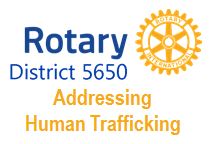As many of you may recall, at the International Convention in Atlanta last June, there was a strong push to address human trafficking (see definition below). Ashton Kutcher spoke eloquently about this issue and encouraged districts around the world to address the topic.
The International Labour Organization estimated in 2015 that 21 million people are trafficked world wide with 55% female. Of the 21 million 26% are 18 or younger.
Another speaker at the Convention was survivor and victims advocate Dorsey Jones who said over 35,000 calls have come in to a national hotline since its inception in 2007. The hotline is 1-888-373-7888.
Nebraska and Iowa have a serious problem in this area as well. In response Sharon Wherry and I and a number of others have been meeting with legislators, law enforcement, survivors advocates and NGOs to learn more about services provided and more importantly gaps in services. Our district has formed an ad hoc committee to address this concern over the next several years. I have invited some people to serve on a steering committee. We welcome interested people and clubs to participate in attacking this problem. Please email me with your thoughts and ideas. The definition below was provided in a US State Dept. Report issued in 2015 by Sec. of State John Kerry.
What is trafficking?: A United States Department of State report in 2015 defines it as: “Trafficking in persons,” “human trafficking,” and “modern slavery” have been used as umbrella terms for the act of recruiting, harboring, transporting, providing, or obtaining a person for compelled labor or commercial sex acts through the use of force, fraud, or coercion. The Trafficking Victims Protection Act of 2000 (Pub. L. 106-386), as amended (TVPA), and the Protocol to Prevent, Suppress and Punish Trafficking in Persons, Especially Women and Children, supplementing the United Nations Convention against Transnational Organized Crime (the Palermo Protocol) describe this compelled service using a number of different terms, including involuntary servitude, slavery or practices similar to slavery, debt bondage, and forced labor.
Human trafficking can include, but does not require, movement. People may be considered trafficking victims regardless of whether they were born into a state of servitude, were exploited in their hometown, were transported to the exploitative situation, previously consented to work for a trafficker, or participated in a crime as a direct result of being subjected to trafficking. At the heart of this phenomenon is the traffickers’ goal of exploiting and enslaving their victims and the myriad coercive and deceptive practices they use to do so.
